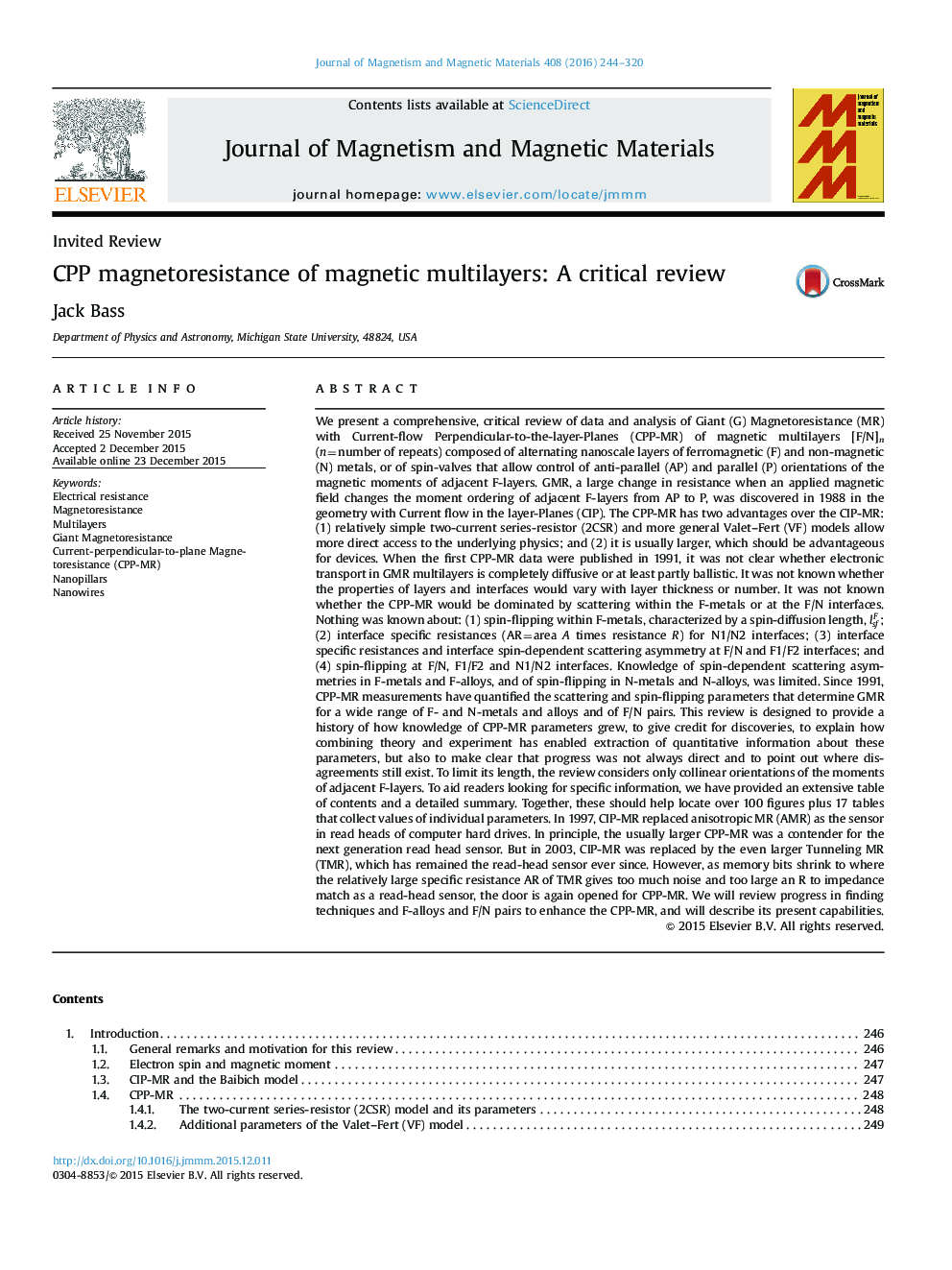| کد مقاله | کد نشریه | سال انتشار | مقاله انگلیسی | نسخه تمام متن |
|---|---|---|---|---|
| 1798237 | 1524813 | 2016 | 77 صفحه PDF | دانلود رایگان |
عنوان انگلیسی مقاله ISI
CPP magnetoresistance of magnetic multilayers: A critical review
دانلود مقاله + سفارش ترجمه
دانلود مقاله ISI انگلیسی
رایگان برای ایرانیان
کلمات کلیدی
موضوعات مرتبط
مهندسی و علوم پایه
فیزیک و نجوم
فیزیک ماده چگال
پیش نمایش صفحه اول مقاله

چکیده انگلیسی
We present a comprehensive, critical review of data and analysis of Giant (G) Magnetoresistance (MR) with Current-flow Perpendicular-to-the-layer-Planes (CPP-MR) of magnetic multilayers [F/N]n (n=number of repeats) composed of alternating nanoscale layers of ferromagnetic (F) and non-magnetic (N) metals, or of spin-valves that allow control of anti-parallel (AP) and parallel (P) orientations of the magnetic moments of adjacent F-layers. GMR, a large change in resistance when an applied magnetic field changes the moment ordering of adjacent F-layers from AP to P, was discovered in 1988 in the geometry with Current flow in the layer-Planes (CIP). The CPP-MR has two advantages over the CIP-MR: (1) relatively simple two-current series-resistor (2CSR) and more general Valet-Fert (VF) models allow more direct access to the underlying physics; and (2) it is usually larger, which should be advantageous for devices. When the first CPP-MR data were published in 1991, it was not clear whether electronic transport in GMR multilayers is completely diffusive or at least partly ballistic. It was not known whether the properties of layers and interfaces would vary with layer thickness or number. It was not known whether the CPP-MR would be dominated by scattering within the F-metals or at the F/N interfaces. Nothing was known about: (1) spin-flipping within F-metals, characterized by a spin-diffusion length, lsfF; (2) interface specific resistances (AR=area A times resistance R) for N1/N2 interfaces; (3) interface specific resistances and interface spin-dependent scattering asymmetry at F/N and F1/F2 interfaces; and (4) spin-flipping at F/N, F1/F2 and N1/N2 interfaces. Knowledge of spin-dependent scattering asymmetries in F-metals and F-alloys, and of spin-flipping in N-metals and N-alloys, was limited. Since 1991, CPP-MR measurements have quantified the scattering and spin-flipping parameters that determine GMR for a wide range of F- and N-metals and alloys and of F/N pairs. This review is designed to provide a history of how knowledge of CPP-MR parameters grew, to give credit for discoveries, to explain how combining theory and experiment has enabled extraction of quantitative information about these parameters, but also to make clear that progress was not always direct and to point out where disagreements still exist. To limit its length, the review considers only collinear orientations of the moments of adjacent F-layers. To aid readers looking for specific information, we have provided an extensive table of contents and a detailed summary. Together, these should help locate over 100 figures plus 17 tables that collect values of individual parameters. In 1997, CIP-MR replaced anisotropic MR (AMR) as the sensor in read heads of computer hard drives. In principle, the usually larger CPP-MR was a contender for the next generation read head sensor. But in 2003, CIP-MR was replaced by the even larger Tunneling MR (TMR), which has remained the read-head sensor ever since. However, as memory bits shrink to where the relatively large specific resistance AR of TMR gives too much noise and too large an R to impedance match as a read-head sensor, the door is again opened for CPP-MR. We will review progress in finding techniques and F-alloys and F/N pairs to enhance the CPP-MR, and will describe its present capabilities.
ناشر
Database: Elsevier - ScienceDirect (ساینس دایرکت)
Journal: Journal of Magnetism and Magnetic Materials - Volume 408, 15 June 2016, Pages 244-320
Journal: Journal of Magnetism and Magnetic Materials - Volume 408, 15 June 2016, Pages 244-320
نویسندگان
Jack Bass,